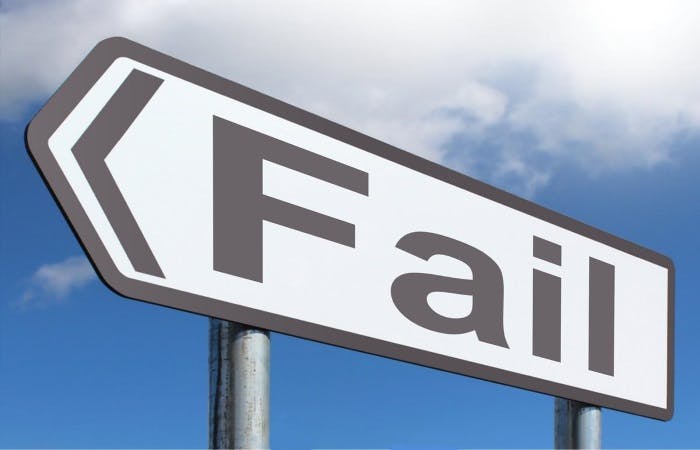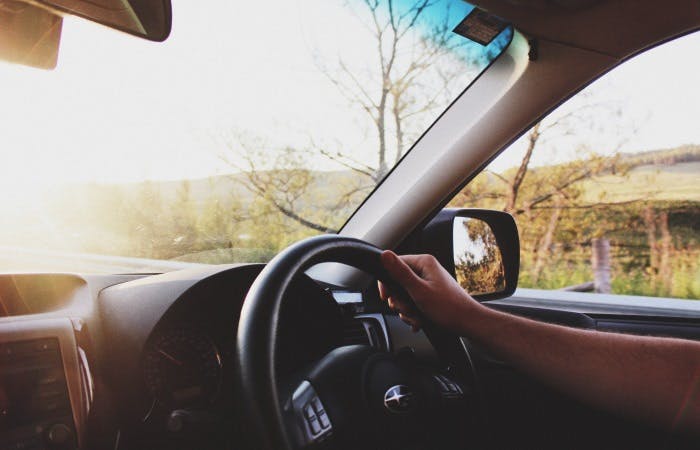
The stats don’t lie: more practical tests result in a fail than a pass. So, how can you avoid the most common mistakes that learners make and pass your test with no sweat?
Well, luckily for the UK’s learner drivers, the DVSA has revealed the top 10 reasons that people failed their driving tests. In this guide we take an in-depth look at each mistake and how you can avoid them.
Let’s get to it!
Top 10 Reasons for Failing the Practical Test in 2024
1. Observation at junctions

We’ll start with the most common reason to fail your driving test: observation at junctions. This one has been causing a headache for candidates for years now. In fact, it’s been the #1 reason every single year the DVSA has released these stats—all the way back to 2006!
So, what is it about observation at junctions that causes so much trouble?
First off, there's the fact that junctions come in all shapes and sizes, from unmarked crossroads to different types of roundabout. Next, add in the fact that this category of fault encompasses basically everything that can go wrong when emerging from a junction. Not looking in both directions is an obvious one, but other potential faults include emerging into oncoming traffic or when traffic is too close.
Put it all together, and you've got a recipe for many, many driving test fails over the years.
Examples of faults:
- Failing to look in both directions before emerging
- Emerging into oncoming traffic
- No attempt at observation at unmarked crossroads
Avoid this by... carrying out careful observations every time you reach any kind of junction. This is especially important when you reach a closed junction, where your view of the road ahead isn't clear. Here, you'll need to put the ‘creep and peep’ method into use—slowly creeping forward to give yourself a better view of the road. Only when it's safe for you to fully emerge should you do so. For more info, check out our guide to observation at junctions!
2. Use of mirrors when changing direction

Your mirrors come into play constantly while you're on the road. You should be making use of them from before you set off to the moment you park up.
A range of different driving test faults come down to failing to check your car mirrors. These include not checking before signalling, changing speed, stopping, and changing direction. We’re focusing on that last one here, as it’s the second-most likely reason for a learner to fail their test.
It’s vital that you check all of your mirrors while making a turn. However, this subcategory is broader than you might think. It also comes into play when you change lanes on a dual carriageway—after all, you need to make sure that you won’t collide with another vehicle before you move over! Additionally, you need to make constant use of your mirrors when overtaking, ensuring that you’re safe to move out, complete the manoeuvre, and move back into your lane.
Examples of faults:
- Failing to check mirrors before turning
- Not checking mirrors when switching lanes
- No mirror checks before, during or after an overtaking manoeuvre
Avoid this by... checking your mirrors! This one really is simple: any time you complete a manoeuvre, your mirrors should be the first thing you go to. It's no accident that Mirror, Signal, Manoeuvre (MSM) is one of the most common mantras in the world of driving tuition!
3. Proper use of steering controls

One of the largest sections on the driving test mark sheet concerns control. This refers to using all of the main controls of the car “smoothly and at the correct time”.
The common learner bugbear, the clutch, features in this section. But, surprisingly, clutch control doesn’t make our top 10. Instead, it’s steering that seems to be causing the most problems for practical test candidates.
There are plenty of problems that can occur when steering a car. Contrary to popular belief, you don't have to keep your hands at 10 and 2—though this is certainly a good place for them to be! Incorrect hand position can result in a fault, though. Other problems likely to trip up learners include crossing your hands over the wheel and losing control as a result, taking both hands off the wheel, or letting the wheel spin back.
Examples of faults:
- Oversteering/understeering around corners
- Keeping one hand off the wheel for too long (e.g., on the gear stick)
- Incorrect hand position on the wheel
Avoid this by... making sure that you have control over the steering wheel at all times. You should always have at least one hand on the wheel, and should have both hands on the wheel whenever possible. Try to adopt a ‘push and pull’ motion to steer, rather than turning your hands with the wheel. Need more tips? You've guessed it: we've got a guide to steering!
4. Turning right at junctions

As we drive on the left-hand side of the road in the UK, turning right is trickier than turning left. After all, to turn right you’ll need to drive across the oncoming lane, so you need to be cautious. With this in mind, it’s not too surprising to find out that it’s made the top 5 reasons why learners failed their driving test in 2019/20.
This particular category encompasses a range of different issues related to your position on the road. When preparing to turn right, you should be close to, but not over, the centre line. Straying over, or keeping too far left, can earn you faults.
In certain circumstances, you may need to use a specific lane for turning right. Other issues may include not giving space to oncoming traffic, or failing to move past the stop line on a green light.
Examples of faults:
- Positioned too far to the left, or over the centre line
- Not using a centre/right hand lane when one is available
- Failing to move forward so as to give space to oncoming traffic
Avoid this by... getting your vehicle into the right position. This should be done well in advance, allowing other motorists space to go straight on or turn left, and signalling your intent to turn right. See how to deal with junctions for information on this and many related topics.
5. Moving off safely
Faults in the moving off category come in two halves, both of which make the top 10 reasons for failing your test. Here we cover moving off safely, and the other part of the equation is vehicle control, which we touch on later in this guide.
Making sure that you're safe to go every time you move off is something your examiner will be looking at very closely. This isn't something you only need to worry about at the very start of your drive, but every time you pull up at the side of the road and get going again.
Naturally, observation is a huge part of this. A good technique is to look around in a clockwise fashion, starting with your left blind spot, then left wing mirror, rear view mirror, windscreen, right wing mirror, and right blind spot. If you’re happy it’s safe, then signal your intent to move out, and perform a final check before moving off. Failing to carry out observations and forgetting the blind spots are common errors that catch candidates out.
Examples of faults:
- Not carrying out any observations
- Failing to check blind spots
- Moving off when unsafe to do so
Avoid this by... building a routine of observation into your drive every time you move off. The clockwise pattern given above is one example, but you can use anything that works for you, provided that it encompasses all of the same components. As an extra tip, you should only carry out your checks once you're satisfied with the set up of your car.
6. Response to traffic lights

You might think that traffic lights are one of the easiest things to obey while on the road. Unfortunately, it seems that they manage to catch out plenty of driving test candidates every year, hence their appearance on our list.
You probably have a good idea of how to avoid this fault. Stopping on red is a no-brainer. You’ll also need to stop on amber—though this is where things get slightly more complicated, as it may be safer for you to continue rather than braking harshly. Either way, you should always assess whether the road ahead is clear, even if a green light is showing.
Examples of faults:
- Driving through (or attempting to drive through) a red light
- Failing to wait for red and amber lights to change to green before driving away
- Not stopping on amber when safe (e.g., before the 'point of no return')
Avoid this by... staying behind the stop line while the lights are on red. When the lights change to red/amber, prepare to go, but don't move forward. Check that it's safe to go before moving away on green. Finally, if the lights are amber, stop if safe to do so. Read up on our guide to the traffic light sequence for more info.
7. Positioning during normal driving
When you first start driving, it can take a little time to figure out where your car should sit in the road. Over time, you'll gain a better understanding of positioning. During the practical test, your examiner will be checking that you've honed this skill.
The general rule of thumb here is to stay in the middle of the left-hand side of the road—neither too close to the kerb nor to the centre line. Depending on the road itself, your direction of travel and any hazards that you come across, you may need to adjust your position.
Examples of faults:
- Driving too close to the kerb
- Positioning your car too far out into the middle of the road
- Moving in and out between parked cars unnecessarily
Avoid this by... using reference points to gauge your car's position on the road. For many learners, an effective technique is to try to position your car so that your steering wheel appears to be in the centre of the road.
8. Response to traffic signs
This one is fairly straight-forward (especially if you’ve passed your theory test) and most test faults come from failing to obey road signs you see along your route.
To become a fully-qualified driver, you should be able to identify all of the most common UK road signs and be able to adapt your driving accordingly. From speed limits to stop signs, you need to show that you can respond appropriately.
One thing to be aware of is that accidentally going the wrong way, such as missing a turn, isn’t a fault as long as you continue to drive safely. So, if you’re one of the 20% of students following traffic signs during your independent driving section, you wouldn’t receive a penalty for going in the wrong direction. The important thing is to check that you’re following the rules of the road.
Examples of faults:
- Disregarding speed limit signs
- Failing to obey mandatory signs
- Ignoring signs warning you against or prohibiting you from doing something
Avoid this by... brushing up on the meaning of traffic signs before your test, and ensuring that your observations are up to snuff so that you don't miss any crucial signs along your route.
9. Response to road markings
Another one that should come fairly easily for everybody sitting their practical test, because they've already made light work of the the theory test. However, pressure brings mistakes and mistakes bring driving test fails!
There are a lot of different road markings out there, but some of the most common reasons for getting a fault are:
- crossing or straddling double white lines
- driving in a bus lane at a prohibitied time
- parking on double yellows
- ignoring box junctions
- ignorning worded markings, e.g., 'Keep Clear'
Avoid this by... learning all your road markings and keeping your theory test revision fresh in your mind ready for your practical test. If you're not sure you can make it over a junction without getting stuck in the hatched box, don't risk it!
10. Control when performing a reverse park
Manoeuvres—it’s a word that strikes fear into most learner drivers (and anyone trying to spell it...). No fear though, this guide will help you to get to grips with them.
There are four different manoeuvres that can appear on your test: forward bay parking, reverse bay parking, parallel parking and pulling up on the right.
Reverse bay parking and parallel parking both fall under the category of ‘reverse park’ according to the official mark scheme, so it’s no surprise this double-whammy makes the top 10 list. When we looked deeper into the stats, maintaining control over the vehicle while reverse parking is the main thing that challenges candidates.
As this covers two different manoeuvres, you need to be aware of what can cause you to slip up on both. With reverse bay parking, you need to finish up within the lines with your car straight. For parallel parking, ensure that you’re close to the kerb without striking it, remain parallel to the kerb (and not at an angle), and stay within two car lengths of the vehicle in front. In both cases, you need to demonstrate good clutch control, without accelerating or braking too harshly.
Examples of faults:
- Parking too close to other vehicles
- Hitting the kerb
- Inadequate clutch control
Avoid this by... practising the manoeuvres regularly before heading into your test! While performing the manoeuvre, keep your speed slow through effective clutch control, and observe at every step. Get more detailed information with our guides to pulling up on the right, bay parking and parallel parking.
That's all for our list! Most of these reasons have appeared in top 10 lists year after year, and have caused long-term problems for drivers. Now you know the top 10 reasons for failing, you're armed with all the info you need to tackle any weak spots in your driving.
Subscribe for driving advice, offers & more
We'd love to let you know about our courses, news and offers via email. You may unsubscribe at any time.
Star Genie Limited trading as PassMeFast. Company number 10093359
Copyright © 2024 owned by Star Genie Limited
PassMeFast, Blue Tower, MediaCityUK, Salford, M50 2ST

